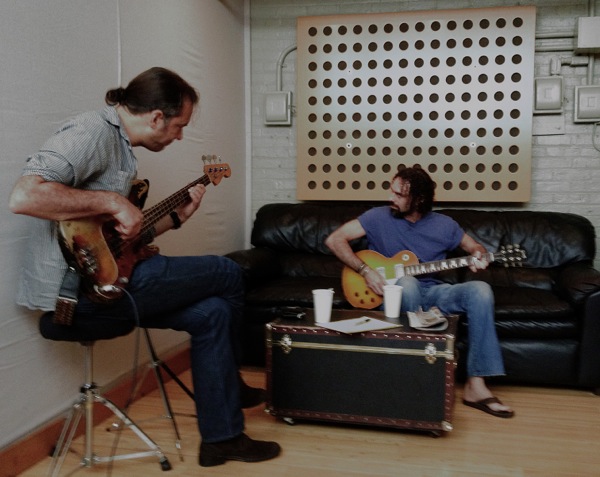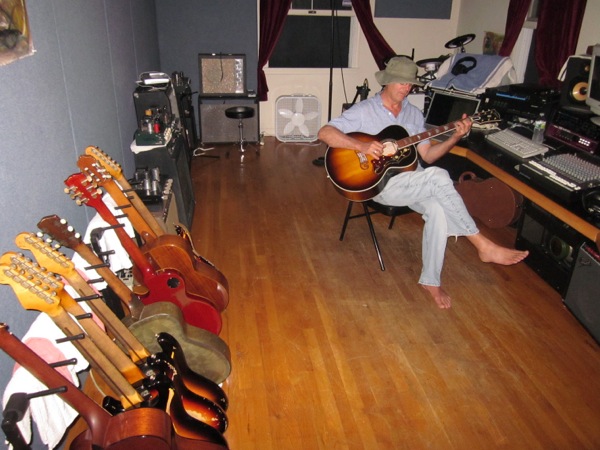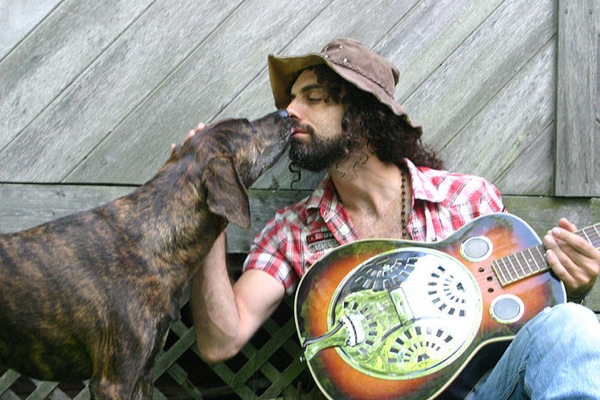By: Debra Devi
Images courtesy of Debra Devi.
How does a Jersey rocker with the kind of huge soulful voice possessed by only a royal few (think Paul Rodgers meets Chris Robinson) wind up creating trippy-yet-hooky, vintage-yet-futuristic, slammin’ rock-and-roll with seminal synth-guitarist Chuck Hammer (Bowie, Lou Reed)?
Not how you might think.
Although Hammer’s roots are in rock, what he wanted from Wiser Time singer and guitarist Carmen Sclafani initially was a bit–unusual.
“I invited Carmen into my studio to cut a couple tracks that required him to–on the spot–invent a vocal language,” Hammer explains. “I wanted something not in English. I wanted a kind of primitive, pre-language vocal. He did such a great job of layering his vocals in a completely invented language that I realized he was someone I wanted to collaborate with further.”
Hammer began expanding the guitar’s vocabulary when he toured with Lou Reed from 1978 to 1980, re-creating string parts from Berlin, Street Hassle and The Bells live with a Roland GR 500 guitar/synthesizer. Back home in NYC, Hammer layered guitar and guitar-synth tracks to create “Guitarchitecture” instrumental works, like his Glacial Guitars album.
These caught David Bowie’s ear, who invited Hammer to record on Scary Monsters. Rolling Stone named him a guitar “pioneer,” in a select group with Robert Fripp and Allan Holdsworth. Today, Hammer is also an Emmy-nominated soundtrack composer for shows including Trauma: Life and Death in the E.R. and The First 48, and has collaborated with avant-garde artists like Laurie Anderson.
Sclafani’s classic-rock band, Wiser Time, had already released three fine albums of ‘70s-influenced rock–There and Back Again, All for One and Beggars and Thieves—when he met Hammer at a jam session. Once Hammer heard Sclafani’s latest songs, the two found common ground in a mutual desire to love and honor the rockness inherent in cranking guitars through vintage tube amps–yet nudge it into the future.
They co-produced Wiser Time’s new EP, XII, which flows without pause from the swirling instrumental “Renaissance” to Sclafani’s righteous rock anthem “Gonna Be Alright.” Former Gov’t Mule/Black Crowes bassist Andy Hess and drummer Steve Decker laid down thick grooves, and keyboardist Rob Clores (Black Crowes, Warren Haynes) added Hammond B-3 organ and bluesy piano. Sclafani’s Wiser Time partner, Jimmy Somma of Sommatone Amplification, contributed blues-rock leads, plus the pick of his sweet boutique amps.
“There’s a real sense of rebirth happening right now that I wanted to express on XII,” Sclafani notes. “We’ve all had to persevere through so much adversity over the last ten years, and I think many people are embracing the idea of ‘moving forward’ in a more positive direction. It’s gonna be alright!”
“I think people can clearly hear my rock ‘n’ roll roots in the flow of my first three albums,” Sclafani adds, “and with XII, Chuck brought Wiser Time’s classic sound into a more modern place with technology and the influence of his creative process. This EP is just a taste of what we’ve got cooking!”
More tracks are in the works, including some with drummer Billy Martin of Martin, Medeski & Wood. These are some exciting collaborations with the potential to refresh and revitalize the guitar’s role in rock, so Guitar International had a few questions for Hammer and Sclafani.

Andy Hess and Carmen Sclafani
******
Guitar International: How did you guys connect?
Carmen Sclafani: I met Chuck at a jam. I was cutting piano tracks for XII with Rob Clores at Showplace Studios in NJ, and invited Chuck to the session. I wanted him to get familiar with the music so that we could try to add some backwards guitar tracks.
Guitar International: How would you describe Wiser Time’s sound?
Carmen Sclafani: Wiser Time is a shepherd’s pie of rock n roll. The body of work covers a lot of ground, but the “vibe” is definitely rooted in the spirit of ‘60s and ‘70s rock and blues.
My music education came in the ‘90s when Seattle just exploded, and so many musical genres were accessible. I’ve been influenced by many different styles of music, and I’ve made a conscious effort to allow my creative process to be influenced by the people around me.
Chuck Hammer: The expressive feel of Carmen’s music reminded me of the early re-imagining of the blues in London in the early 1960s, which led into the psychedelic movement. When he told me he was interested in doing something tied into a visionary psychedelic sound, it felt right to explore and integrate that sonic ground.
Carmen was interested in the feeling of something visionary, explosive, colorful and psychedelic. Rob had played these beautiful, regal, modal chords, so I began looking for sinewy, serpentine lines to play on the guitar.
Carmen had played me some scratch versions of his idea, but because they were done on electric guitar they were almost too close to a Hendrix vibe. Instead the idea of using backwards acoustic guitar gave us an alternative sonic direction, and put us into the new territory we were seeking.
Guitar International: The “Renaissance” instrumental on XII is gorgeous—and complex. What is going on there?
Chuck Hammer: Rob was playing really beautiful keyboard layering that wasn’t all being used on the main body of the track. I had the idea to lift those out and co-compose an introduction to the entire piece.
I sorted thru Rob’s parts, moving them around and editing them to maximize the textures. Then I started to fool around with a 1968 Guild D-40 that I used to take on tour with Lou Reed as my “hotel room” travel guitar. I added single note lines in a Jimmy Page-ish, raga style open tuning. I took those lines and started flipping them backwards on Pro Tools and layering them. They sounded so good!
Although there’s no guitar synth on the track, it has the textures of something synthetic, because it’s multi-tracked single strings that have been reversed and moved around so that they have peaks and valleys that fit with Clores’s piano parts. It took about six weeks to create.

Chuck Hammer in his studio
Guitar International: Chuck, would you explain your Guitarchitecture concept?
Chuck Hammer: Guitarchitecture evolved when I was working with Lou Reed in the late ‘70s. He had a string section on the Berlin album, and I was experimenting with ways to play those parts using the Roland GR 500 guitar/synthesizer.
I came up with the idea of breaking a chord apart. Take a simple D chord, for example – D, F#, A – you can play that in four different inversions times three notes. That’s twelve notes. It starts to sound very big, and it’s beautiful when you hear them move between even simple chords like from I to V (D to A) or I to IV (D to G). Each track is leaving the previous note at a slightly different time. This is exactly what a chorus pedal is trying to do, but does very poorly. You’re literally breaking apart the notes.
I was breaking chords into individual notes and stacking the notes so each note would have its individual vibrato–much like an orchestra. If you look at an orchestral score, it might be broken out to twenty-five strings. They might be playing only one chord, but they’re voiced very broadly and widely across the string section.
Guitar International: How does modern technology fit into your arsenal now?
Chuck Hammer: I consider Pro Tools to be an instrument. I play guitar and Pro Tools. The electric guitar is so overexposed that it’s difficult to come up with something unique in a linear fashion. When I use Pro Tools, playing the guitar becomes much more akin to painting. Painters can paint over an image, they work it. Using Pro Tools, Guitarchitecture has evolved so I can literally erase, paint over and move bits of music around, building the density and changing the textures on the canvas itself.
I’m sure every guitarist has experienced this – sometimes you play something magical, sometimes you don’t. With Pro Tools you can play freely, knowing you can erase everything you don’t like and keep only the most magical, quality parts.
I’m still very interested in guitar synthesis but I started experimenting with the idea of cutting electric guitar into very small tracks. I’ll cut away the uninteresting part of a track and record another track. I’ll wind up with sonic guitar events – eight seconds here, three seconds here – keeping only the bits that strike me as very magical, very interesting and then re-combining them into a fully woven track.
It’s a new evolution of Guitarchitecture. That was what I did on XII. Everything was played organically but only the most cherry parts survived.
Guitar International: Who is playing lead guitar on “Gonna Be Alright” It has a great bluesy, classic rock feel–yet you’re also taking that sound forward with creative new sounds.
Carmen Sclafani: Jimmy Somma is playing lead guitar on that track. Jimmy has a great blues-rock-feel, and I love what he brings to Wiser Time. He did a great job of playing to the vibe of the track and allowing it to breath. It’s very tasty playing.

Carmen Sclafani of Wiser Time
Guitar International: Please share some details about guitars and amps you used, and any interesting recording techniques. We’re guitar geeks here, we wanna know!
Carmen Sclafani: For the riff on “Gonna Be Alright,” I played a Gibson ‘60s Les Paul Custom Standard through a Sommatone “Vibe 45” tube amp with pair of EL34’s. I also used an acoustic Gibson SJ-200 with a birdseye maple body.
Jimmy played leads on “Gonna Be Alright” with a custom Sommatone Tele with a swamp ash body, maple neck with a rosewood fret board and Lollar Imperial humbuckers. He ran it through a Sommatone Overdrive-35 with a pair of 6L6s and Celestion Lynchback speakers.
We used tube-driven spring reverb, and all overdriven tones came from the amps…no OD pedals!! We used SM57 mics on the guitars.
Chuck Hammer I tried many different acoustic guitar mic techniques but I ended up recording these guitars in mono with a vintage Neumann U87 from the late ‘70s. Charlie Bugby, a producer who worked with Peter Townshend, on the Lincoln Center PRODUCITON OF TOMMY gave me that microphone when I was building my studio. I was finger-picking if I’m not mistaken.
I ran the mic into a Millennia Media HV3 preamp, through a vintage Sony broadcast console, and then took that mono signal into a mid ‘80s Lexicon PCM70 processor–which turned it into a stereo signal. I printed that stereo signal to Pro Tools. The signal path is one aspect towards what made it sound unique.
Guitar International: What inspired the songs/lyrics for XII? What message do you hope listeners carry away with them?
Carmen Sclafani: We’re in pretty interesting times. A lot of people look to words and music for strength and inspiration. If listeners carry anything away, I hope that it’s a sense of perseverance and optimism. This can be our “Imagine” moment, if we let it be.
Bass Guitar | Doing it for the troops (11 years ago)
[…] Chuck Hammer's Guitarchitecture Meets Wiser Time Former Gov't Mule/Black Crowes bassist Andy Hess and drummer Steve Decker laid down thick grooves, and keyboardist Rob Clores (Black Crowes, Warren Haynes) added Hammond B-3 organ and bluesy piano. Sclafani's Wiser Time … I play guitar and Pro Tools … Read more on Guitar International […]